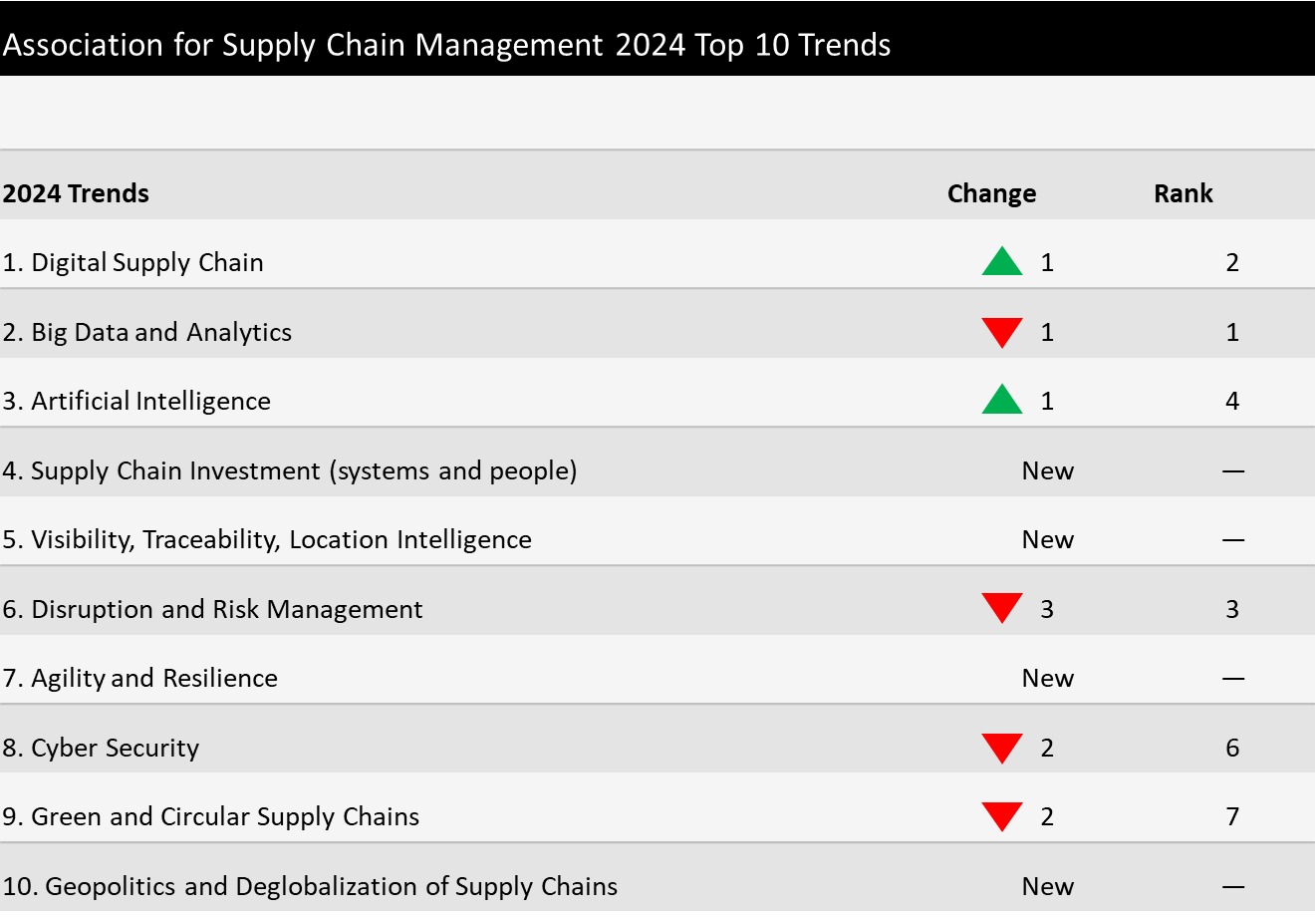Top 10 2024 Supply Chain Trends: Beware of the Analytics Rabbit Hole

The best and brightest minds in supply chain gathered in Louisville, Kentucky, this week for the Association for Supply Chain Management’s (ASCM)1 annual conference.2 Much like the city of Louisville is renowned for being the birthplace of the Louisville Slugger,3 the standard in major league baseball bats, ASCM is the home of the Supply Chain Operations Reference Digital Standard (SCOR-DS)4 model, the standard for supply chain transformation methodology. The most anticipated moment at the ASCM conference each year is the release of the 10 top supply chain trends5 voted on by the global ASCM membership.
The 2024 Top 10 Trends Are in
The digital supply chain claimed the number one spot for 2024’s supply chain trends (see Figure 1), ending big data, advanced analytics and automation’s four-year run as the top trend. The digital supply chain6 has risen to prominence because it is viewed as the backbone for streamlining various supply chain activities. For example, digital capabilities have replaced paper and antiquated processes, leading to a more agile supply chain architecture.

Figure 1. ASCM top 10 2024 supply chain trends list
This enhanced architecture allows companies to respond quickly to day-to-day requests, including dynamically changing orders. Most importantly, it affords organizations the resiliency to react to future supply chain shocks or Black Swan events. The pandemic, one of the most notable disruptors, almost singlehandedly brought the supply chain digital agenda from behind the curtain to center stage. News in national and international media consistently reported on out of stocks, runs on product categories, container shortages, worker shortages and logistics headaches. The overwhelming disruption drove digital innovation and the necessity to completely transform antiquated supply chain processes and capabilities.
Now, supply chain organizations around the world are in the midst of taking the next step to completely digitize their supply chain. Interestingly, the ASCM board was unanimous in their agreement on data’s role. Through this ongoing supply chain transformation, ASCM now emphasizes the paramount importance of data in bringing about a more agile supply chain.
Beware of the Analytics Rabbit Hole
In fact, data is critical to supply chain transformation. It’s no coincidence that four out of the top five ASCM 2024 supply chain trends directly involve data. These include “big data and analytics,” “artificial intelligence (AI),” “supply chain investments (systems and people)” and “visibility, traceability, and location intelligence.”
In a fascinating twist, while digital supply chains require data, the trend it displaced for the top spot was all about data (big data, analytics and automation). The primary reason cited by the ASCM membership for this change? The data itself. Are analytics really telling the right story and why are spreadsheets driving the process? If the data driving the analytics is not correct, it can become very easy to go down the wrong rabbit hole. The incorrect rabbit hole can result in severe business consequences, wasting time, money and resources, with the wrong course being charted for the supply chain team and the company.
The ASCM board was quite emphatic that to get value out of data and take advantage of the 2024 supply chain trends, data must be the focus. It must be relevant, clean and governed. Otherwise, the risk of running down the wrong rabbit hole becomes very real.
Data and Analytics Drive Sustainability
ESG regulations are arriving in the U.S. in 2024,7 requiring public companies to report their greenhouse gas emissions.8 These mandates are already in place in many geographies across the globe.
As expected, sustainability was a red-hot topic at the ASCM event with the focus on sustainable supply chains. Keynote speaker Elliott Harris,9 the United Nations Chief Economist, discussed “Global Perspective on Supply Chain Recovery and Resilience.” Over the course of the three-day event, there were an additional 13 sustainability breakout sessions.10 In fact, the ASCM’s latest version of the SCOR DS11 includes sustainability standards as part of the supply chain orchestration process.
With all the focus on ESG and sustainability, why did green and circular supply chains12 fall two spots in the top 10 supply chain trends for 2024? The feedback from conference members was that circular supply chain projects have two challenges in today’s uncertain economy:
- Senior-level executive buy-in is tough if projects do not show direct top-line or bottom-line impact.
- The entire value chain must participate for a circular supply chain program to be effective.
The obvious response to the feedback is that regulation is coming. You can either get ahead of it or be forced to react to it. However, there was a more intriguing response: Use the other data trends to drive sustainability and circular supply chain projects.
For instance, trend number five on the list involves traceability. Most traceability projects tie the supply chain together across suppliers for things like recalls and returns. It is not a big leap to take ESG data and overlay it into the very same data points and attributes involved in traceability.
The benefit will be that large companies can easily trace materials and inventory by supplier. They can also quickly see which suppliers are meeting sustainability goals for the company and whether they’re regulated by the geography the company does business in. This can allow for quick sourcing of new suppliers for performance reasons or responsible sourcing.
Supply Chain Data Management
Considering the ASCM 2024 supply chain trends, companies and supply chain teams that excel at enterprise data management will be the real winners. They will look to drive a digital supply chain built upon a well-thought-out framework like SCOR DS. out framework like SCOR DS.
But supply chain data stands apart due to its inherent silos and disparities and its presence both within and outside an organization’s four walls. The companies that can effectively manage supply chain data from disparate sources — and create a trusted foundation of reliable, clean, governed data regardless of where the data lives — will be able to take advantage of game-changing trends like AI. And that calls for supply chain data management from Informatica.
Next Steps
To learn how we can help you build an agile supply chain, visit www.informatica.com, and join us this fall in a city near you as Informatica World Tour goes on the road.
1https://www.ascm.org/about-ascm/
2https://connect.ascm.org/website/55509/
3https://www.sluggermuseum.com/
4https://www.ascm.org/corporate-solutions/standards-tools/scor-ds/
5https://www.scmr.com/article/digital-supply-chain-tops-ascms-top-10-supply-chain-trends-for-2024
6https://www2.deloitte.com/us/en/pages/operations/solutions/next-generation-supply-chain-model.html
7https://www.sec.gov/news/statement/gensler-statement-esg-disclosures-proposal-052522
8https://watershed.com/blog/esg-disclosure-toolkit
9https://www.un.org/en/desa/page/elliott-harris-assistant-secretary-general
10https://connect.ascm.org/website/55509/agenda/#full-agenda
11https://www.ascm.org/globalassets/ascm_website_assets/docs/intro-and-front-matter-scor-digital-standard2.pdf
12https://www.globaltrademag.com/the-circular-economys-impact-on-supply-chain-management/








